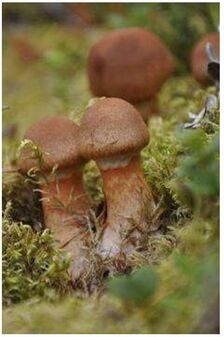A group of scientists in Sweden has found that contrary to popular belief, most of the carbon that is sequestered in northern boreal forests comes about due to fungi that live on and in tree roots, rather than via dead needles, moss and leaf matter. In their paper published in the journal Science, the team describes their findings after taking soil samples from 30 islands in two lakes in northern Sweden.
|
Scientists have known for quite some time that northern forests sequester a lot of carbon—they pull in carbon dioxide after all, and "breath" out oxygen. But what the trees actually do with the carbon has been a matter of debate—most have suggested that it's likely carried to needles and leaves then eventually drops to the forest floor where over time decomposition causes it to leech into the soil. If that were the case, this new team of researchers reasoned, then the newest carbon deposits should appear closest to the surface of the forest floor. But this is not what they found—instead they discovered that newer deposits were more likely to be found at deeper levels in the soil. This was because, they learned, the trees were carrying much of the carbon they pulled in down to their roots (via sugars) where it was being sequestered by a type of fungi (ectomycorrhizal, aka mycorrhizal fungi) that eats the sugars and expels the residue into the soil.
|
In their study they found that 47 percent of soil carbon found on large island samples came about due to fungi, as did a whopping 70 percent of carbon in small island soil samples. Thus far, the team is only able to guess why there are such differences in the soils, but theorize it's likely due to differences in decomposition rates.
The amount of carbon stored in northern forests and how, is important because such trees cover approximately 11 percent of the Earth's surface and recent research has calculated that they hold approximately 16 percent of all worldwide sequestered carbon. And that's important, of course, because as global warming occurs, more sequestered carbon is released due to faster decomposition rates of dead forest matter. What's still not clear, however, is whether an increase in new forest growth due to warmer temperatures in more northern areas is likely to offset the increase in release of the sequestered carbon.
This article has been reprinted with permission from Phys.org.
The amount of carbon stored in northern forests and how, is important because such trees cover approximately 11 percent of the Earth's surface and recent research has calculated that they hold approximately 16 percent of all worldwide sequestered carbon. And that's important, of course, because as global warming occurs, more sequestered carbon is released due to faster decomposition rates of dead forest matter. What's still not clear, however, is whether an increase in new forest growth due to warmer temperatures in more northern areas is likely to offset the increase in release of the sequestered carbon.
This article has been reprinted with permission from Phys.org.



